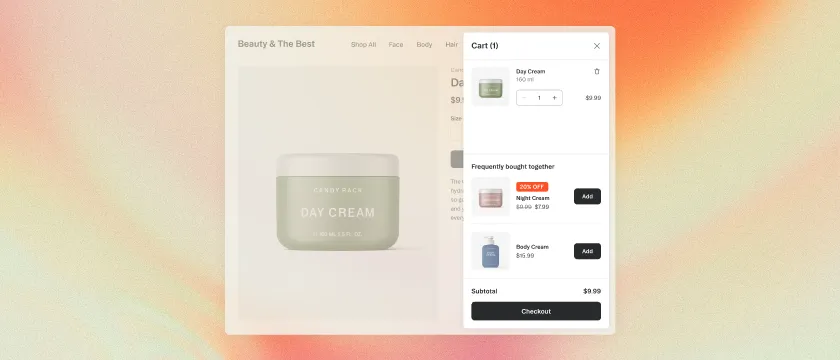Structure and navigation are essential to any e-commerce website. You have to ensure that visitors easily find the products they need, understand your delivery and return policies, know how to contact you, and so on.
Moreover, some navigation tricks can serve not only for great user experience but also as an upselling opportunity.
We’ve covered the major upsell marketing strategies in our previous post, and now, we’ll talk about the things you can implement in your store to get customers hooked from the beginning of their journey, even before they add anything to their cart or proceed to checkout.
Let’s explore what you can do with your store’s navigation and structure to enable cross-selling and upselling opportunities.
1. Feature most popular products, new arrivals, and special deals
A lot of shoppers browse online stores without a clearly shaped desire in mind—and you can provide hints to them. A simple way to do so is to have a block with best-selling items shown on the homepage and collection pages.
When you go to the theme customization settings in your Shopify account, you can create Featured product and Featured products sections, name them the way you want, choose their placement, and select the items to be shown there. It’s the simplest way to add such a block, but you also can use apps or tweak the code for creating featured product sliders, or go for custom development on top of your Shopify theme.

Don’t limit yourself to best-sellers or particular products you want to highlight. If you have some bundles or limited-time deals, it’s worth creating separate blocks with them to attract website visitors.
For instance, if a special occasion is coming up, and your store contains products related to it, navigate customers to those products. Say you’re selling home decor stuff and Mother’s day is around the corner: select everything that might be a nice gift to mothers and create a separate menu item featuring this selection.
Take a look at how Lego highlights its Star Wars-themed deals linked to the Star Wars celebration day—there’s an additional component in the header menu plus a banner that appears among the products:

2. Promote a gift offered under certain spending conditions
Free stuff can be a decision breaker for customers. If you offer them something nice for free, they will be more likely to return to your store: surveys show that gifts grow brand loyalty among 90% of consumers.
The trick is, you have to set some rules. The most common advice here is to set a spending limit that is slightly higher than your AOV. Encourage shoppers to buy more by showing how much they have to spend to get the gift:

You can do the same with free shipping and even show a progress bar in the cart so that customers understand how much more they should spend to get free shipping. E-commerce experts claim that a free shipping threshold should be around 30% of the median cart value.
Shopify apps can help you easily add gifts to orders. For example, with the Gift Box app, you can set different custom conditions for a gift to be given and choose among the different types of gifts or free services.
3. Showcase customization options if there are any
A great way of “true upselling” is personalization—offering the same product but made with some adjustments and a personal touch.
For example, a skincare and beauty brand includes a customization option right in the header menu: there, they offer products from the catalog to be specially made for an extra price. Customers can choose a shampoo, change and mix ingredients, and add their own name to the bottle. They might be fine with a standard shampoo that costs less, but if the customization option looks reasonable to them, they end up paying more and increasing the order value.

4. Create interactive quizzes to offer personalized suggestions
When people know the type of product they need but aren’t sure about the details, a recommendation quiz might work perfectly. It’s especially popular with skincare and cosmetics brands now: in a quiz, customers can specify their characteristics, the problems they want to solve, or even apply their photos—and the system will show best-matching recommendations.

To sum up
There are different ways to upsell customers: with the help of pop-ups, in-cart messages, chatbots, etc. But you also can integrate additional offers into your store’s navigation. This way, your visitors can add more relevant items to the cart without feeling pressured or disturbed. To improve customer experience and boost AOV, consider featuring your bestsellers, giving out gifts for a certain spending threshold, and personalizing product recommendations.
















